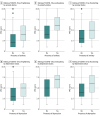Posttraumatic Growth in Intensive Care Unit Health Care Professionals After COVID-19
- PMID: 40853660
- PMCID: PMC12379108
- DOI: 10.1001/jamanetworkopen.2025.27443
Posttraumatic Growth in Intensive Care Unit Health Care Professionals After COVID-19
Abstract
Importance: Posttraumatic growth (PTG) refers to positive psychological changes following adversity, including deeper relationships and a greater appreciation for life.
Objective: To assess PTG among intensive care unit (ICU) health care professionals 4 years after the COVID-19 pandemic and explore its association with resilience, anxiety, and depression.
Design, setting, and participants: This cross-sectional study invited ICU health care professionals (nursing staff, medical staff [residents, interns, clinical fellows, and senior intensivists], and other professionals providing patient care) in ICUs in general or university-affiliated hospitals in France and Belgium to complete online questionnaires between March 15 and May 15, 2024.
Exposures: PTG, resilience, anxiety, and depression.
Main outcomes and measures: The primary outcome was PTG, and secondary outcomes were anxiety, depression, and resilience. Participants completed validated self-reported questionnaires, including the Posttraumatic Growth Inventory (PTGI), Hospital Anxiety and Depression Scale (HADS), and 10-item Connor-Davidson Resilience Scale (CD-RISC 10). Visual analog scales (VASs) assessed professional experiences and psychological impact. Multivariate linear regression identified factors associated with PTG.
Results: Among 1371 health care professionals in 23 ICUs, 850 (62%) responded (median age, 39 years [IQR, 32-46 years]; 574 [68%] women). The median PTGI score was 50 (IQR, 33-64), with nursing staff reporting higher PTG than medical staff (51 [IQR, 34-65] vs 47 [IQR, 28-61]; P = .02), mainly in personal strength, spiritual change, and appreciation of life. Anxiety and depression symptoms were present in 492 respondents (58%) and 219 respondents (26%), respectively. Lower PTG was associated with psychological fatigue (regression coefficient, 1.43; 95% CI, 0.91-1.96; P < .001), ICU conflicts (regression coefficient, 0.62; 95% CI, 0.05-1.19; P = .03), and perceived deterioration in family-centered care (regression coefficient, -7.47; 95% CI, -1.10 to -13.80; P = .02). Higher PTG was correlated with higher resilience (Spearman correlation coefficient, 0.24; 95% CI, 0.17-0.30; P < .001) and was associated with a change in personal life since the pandemic (regression coefficient, 1.80 [95% CI, 1.13-2.47] per VAS point; P < .001).
Conclusions and relevance: In this cross-sectional study performed 4 years after the start of the COVID-19 pandemic, ICU health care professionals, particularly nursing staff, exhibited significant PTG. Resilience, rather than psychological distress, emerged as a key driver of PTG, and deterioration in family-centered care was a major contributing factor, underscoring the need for targeted well-being and resilience-building strategies to enhance health care professionals' mental health and professional fulfillment while also improving patient and family care.
Conflict of interest statement
Figures


Comment in
- doi: 10.1001/jamanetworkopen.2025.27452
References
-
- Rendon J. Upside: The New Science of Post-Traumatic Growth. Touchstone; 2015. Accessed July 1, 2025. https://www.jimrendon.com/
MeSH terms
LinkOut - more resources
Full Text Sources
Medical

